Related Research Articles
Mata Ortiz is a small village in the state of Chihuahua, Mexico, less than 100 miles (160 km) from the US-Mexico border. The community is one of the designated localidades (localities) in the municipio libre (municipality) of Casas Grandes, one of several such pueblos in a wide, fertile valley long inhabited by indigenous people. Mata Ortiz is located at the base of a mountain known as El Indio and on the west bank of the Rio Palanganas, a tributary of the Rio Casas Grandes. The ancient ruins of Casas Grandes are located nearby. As of 2010, Mata Ortiz had a population of 1,182.
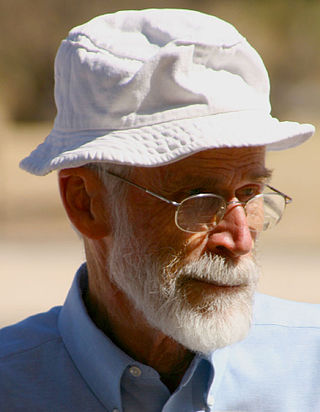
Spencer Heath McCallum, commonly known as Spencer MacCallum, was an American anthropologist, business consultant and author. He was especially noted for his discovery of the pottery of the town of Mata Ortiz, Chihuahua, Mexico.
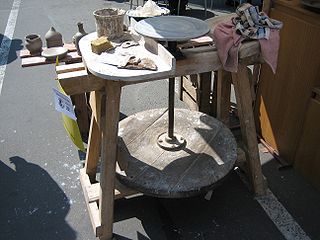
In pottery, a potter's wheel is a machine used in the shaping of clay into round ceramic ware. The wheel may also be used during the process of trimming excess clay from leather-hard dried ware that is stiff but malleable, and for applying incised decoration or rings of colour. Use of the potter's wheel became widespread throughout the Old World but was unknown in the Pre-Columbian New World, where pottery was handmade by methods that included coiling and beating.

Pit firing is the oldest known method for the firing of pottery. Examples have been dated as early as 29,000–25,000 BCE, while the earliest known kiln dates to around 6000 BCE, and was found at the Yarim Tepe site in modern Iraq. Kilns allow higher temperatures to be reached, use fuel more efficiently, and have long replaced pit firing as the most widespread method of firing pottery, although the technique still finds limited use amongst certain studio potters and in Africa.

Lucy Martin Lewis was a Native American potter from Acoma Pueblo, New Mexico. She is known for her black-on-white decorative ceramics made using traditional techniques.
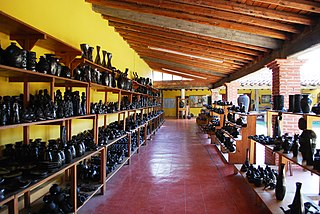
San Bartolo Coyotepec is a town and municipality located in the center of the Mexican state of Oaxaca. It is in the Centro District of the Valles Centrales region about fifteen km south of the capital of Oaxaca.

Santa María Atzompa is a town and municipality located in the Mexican state of Oaxaca, about five km from the state capital of Oaxaca. It is part of the Centro District in the Valles Centrales region. The town was founded between the 7th and 9th centuries as a satellite of the ancient Zapotec city of Monte Albán. Since its founding, pottery making has been a major economic activity and the town is currently known for its green-glazed pottery. This pottery used to be shipped all over Mexico and exported to the United States but today most of this pottery is sold locally. Beginning in 2009, there has been excavation at the Atzompa archeological site, leading to the discovery of a 45-meter Mesoamerican ball court, which has been determined to have been on the principal one for Monte Alban. Today, the town is rustic with the smoke of wood-fired pottery kilns ever present. Poverty has been a concern for the town, but innovations such as the use of lead-free glazing and a communal crafts market have been implemented to improve the craft's prospects.

Green glazed pottery of Atzompa is a style of glazed pottery, which originates in the Oaxaca, Mexico town of Santa María Atzompa. Almost all of the pottery made here is of a jade-green color, due to the lead monoxide glaze which has been traditionally applied to it.

Ceramics in Mexico date back thousands of years before the Pre-Columbian period, when ceramic arts and pottery crafts developed with the first advanced civilizations and cultures of Mesoamerica. With one exception, pre-Hispanic wares were not glazed, but rather burnished and painted with colored fine clay slips. The potter's wheel was unknown as well; pieces were shaped by molding, coiling and other methods.

Ceramics of Jalisco, Mexico has a history that extends far back in the pre Hispanic period, but modern production is the result of techniques introduced by the Spanish during the colonial period and the introduction of high-fire production in the 1950s and 1960s by Jorge Wilmot and Ken Edwards. Today various types of traditional ceramics such as bruñido, canelo and petatillo are still made, along with high fire types like stoneware, with traditional and nontraditional decorative motifs. The two main ceramics centers are Tlaquepaque and Tonalá, with a wide variety of products such as cookware, plates, bowls, piggy banks and many types of figures.

The Soteno family of Metepec is one of the main families of ceramic artisans specializing in sculptures called Trees of Life which have made the town found in the State of Mexico one of Mexico’s main ceramic centers. The Tree of Life is a complicated colorful sculpture which was developed from the creation of candlesticks. The family’s prominence began with Modesta Fernández Mata, the mother, grandmother and great-grandmother of the Soteno potters today, who began experimenting making more decorative items along with utilitarian ones. The generations after her have learned the craft and improved on it starting as children working with parents and grandparents. The two most notable members of the family are Tiburcio and Oscar, second and third generation respectively, who have won various awards and have their works in collections worldwide.

Mata Ortiz pottery is a recreation of the Mogollon pottery found in and around the archeological site of Casas Grandes (Paquimé) in the Mexican state of Chihuahua. Named after the modern town of Mata Ortiz, which is near the archeological site, the style was propagated by Juan Quezada Celado. Quezada learned on his own to recreate this ancient pottery and then went on to update it. By the mid 1970s, Quezada was selling his pottery and teaching family and friends to make it and the pottery was able to penetrate the U.S. markets thanks to efforts by Spencer MacCallum and later Walt Parks along with Mexican traders. By the 1990s, the pottery was being shown in museums and other cultural institutions and sold in fine galleries. The success of the pottery, which is sold for its aesthetic rather than its utilitarian value, has brought the town of Mata Ortiz out of poverty, with most of its population earning income from the industry, directly or indirectly.
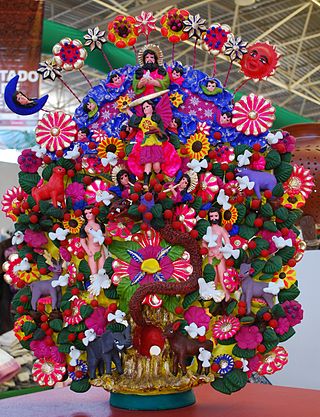
The pottery of Metepec is that of a municipality in central Mexico, located near Mexico City. It is noted for durable utilitarian items but more noted for its decorative and ritual items, especially sculptures called “trees of life,” decorative plaques in sun and moon shapes and mermaid like figures called Tlanchanas. Metepec potters such as the Soteno family have won national and international recognition for their work and the town hosts the annual Concurso Nacional de Alfarería y Cerámica.

Hilario Alejos Madrigal is a Mexican potter from a small town in the state of Michoacán, known for his “pineapple” ceramic wares. The name comes from the original form which was created by his mother, potter Elisa Madrigal Martinez, who created punch bowls in the shape of pineapples. Alejos Madriga’s variations include bowls, candelabras and more, with the version done in a green glaze be best known. Alejos Madrigal has won awards for his work, which is featured on the cover of large reference book Grandes Maestros del Arte Popular Mexicano by Fomento Cultural Banamex.
Lisa Holt and Harlan Reano are a husband-and-wife team of Pueblo potters and artists from northern New Mexico. They have been making pottery together in 1999, they use traditional Cochiti pottery techniques and create modern work.

Chiapas handcrafts and folk art is most represented with the making of pottery, textiles and amber products, though other crafts such as those working with wood, leather and stone are also important. The state is one of Mexico's main handcraft producers, with most artisans being indigenous women, who dominate the production of pottery and textiles. The making of handcrafts has become economically and socially important in the state, especially since the 1980s, with the rise of the tourist market and artisans’ cooperatives and other organizations. These items generally cannot compete with commercially made goods, but rather are sold for their cultural value, primarily in San Cristóbal de las Casas.

Tlaxcala handcrafts and folk art is that which comes from the smallest state in Mexico, located in the center-east of the country. Its best-known wares are the "canes of Apizaco", sawdust carpets and the making of Saltillo-style serapes. However, there are other handcraft traditions, such as the making of pottery, including Talavera type wares, cartoneria, metalworking and stone working. The state supports artisans through the activities of the Fideicomiso Fondo de la Casa de las Artesanía de Tlaxcala
Jami Porter Lara is an artist living in Albuquerque, New Mexico, known primarily for her black vessel-like conceptual sculptures created using millennia-old ceramics techniques indigenous to the Chihuahuan Desert. Porter Lara's work is in public and private collections nationwide, and has been featured in Art 21 Magazine, CFile, Hyperallergic, and on PBS. In 2017, Artsy named her one of the artists shaping the future of ceramics. She is represented by form & concept in Santa Fe, and Simon Breitbard Fine Arts in San Francisco.

Black-on-black ware is a 20th and 21st-century pottery tradition developed by Puebloan Native American ceramic artists in Northern New Mexico. Traditional reduction-fired blackware has been made for centuries by Pueblo artists and other artists around the world. Pueblo black-on-black ware of the past century is produced with a smooth surface, with the designs applied through selective burnishing or the application of refractory slip. Another style involves carving or incising designs and selectively polishing the raised areas. For generations several families from Kha'po Owingeh and P'ohwhóge Owingeh pueblos have been making black-on-black ware with the techniques passed down from matriarch potters. Artists from other pueblos have also produced black-on-black ware. Several contemporary artists have created works honoring the pottery of their ancestors.
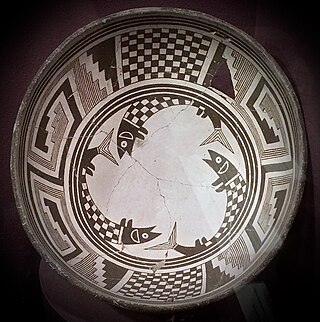
Pueblo pottery are ceramic objects made by the Indigenous Pueblo people and their antecedents, the Ancestral Puebloans and Mogollon cultures in the Southwestern United States and Northern Mexico. For centuries, pottery has been central to pueblo life as a feature of ceremonial and utilitarian usage. The clay is locally sourced, most frequently handmade, and fired traditionally in an earthen pit. These items take the form of storage jars, canteens, serving bowls, seed jars, and ladles. Some utility wares were undecorated except from simple corrugations or marks made with a stick or fingernail, however many examples for centuries were painted with abstract or representational motifs. Some pueblos made effigy vessels, fetishes or figurines. During modern times, pueblo pottery was produced specifically as an art form to serve an economic function. This role is not dissimilar to prehistoric times when pottery was traded throughout the Southwest, and in historic times after contact with the Spanish colonialists.
References
- 1 2 3 4 Grandes Maestros del Arte Popular Mexicano. Mexico City: Collección Fomento Cultural Banamex. 2001. pp. 57–58. ISBN 968-5234-03-5.
- 1 2 3 4 5 6 7 "Juan Quezada Celado". Premio Nacional de Artes y Tradiciones Populares (in Spanish). Mexico City: Secretaría de Educación Pública. Retrieved December 9, 2013.[ permanent dead link ]
- 1 2 3 4 5 6 Walter Parks (December 1999). "The potters of Mata Ortiz". 29 (7). Southwest Art: 70.
{{cite journal}}: Cite journal requires|journal=(help) - 1 2 3 4 Manuel Ruiz Sánchez (May 23, 2011). "Revivió Mata Ortiz gracias a la alfarería". El Heraldo de Chihuahua (in Spanish). Mexico. Archived from the original on December 13, 2013. Retrieved December 9, 2013.
- 1 2 3 4 5 6 7 8 9 10 Patricia Velazquez Yebra (December 11, 1999). "Da la vuelta al mundo el arte en barro de Juan Quezada". El Universal (in Spanish). Mexico City. Retrieved December 9, 2013.
- 1 2 3 4 5 6 7 8 9 Guadalupe Loaeza (August 18, 1999). "Ahi Esta el Detalle / El don de Don Juan". Palabra (in Spanish). Saltillo. p. 7.
- 1 2 3 4 5 6 7 8 9 10 Nancy Andrews (Spring 2012). "Tea with Juan Quezada: An Afternoon at Rancho Barro Blanco". Journal of the Southwest. 54 (1): 177–183. doi:10.1353/jsw.2012.0013. S2CID 161183276.
- 1 2 3 4 5 6 7 8 9 Bill Gilbert. "The Potters of Mata Ortiz Five Barrios, Seven Families" (PDF). Albuquerque: University of New Mexico Art Museum. Retrieved December 9, 2013.
- 1 2 3 "Ancient art of pottery revives north Mexican town". China Daily, North American ed. January 5, 2006. p. 14.
- 1 2 3 4 5 6 7 Mark M Johnson (February 1999). "The potters of Mata Ortiz: Transforming a tradition". 125 (1). Arts and Activities: 29–32.
{{cite journal}}: Cite journal requires|journal=(help)